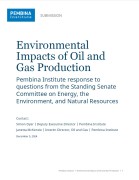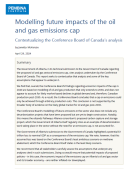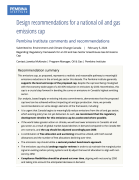For the last two years, the Pembina Institute has been tracking the revenues, cashflow and capital expenditure of Canada’s biggest oilsands producers, in a series entitled Waiting to Launch: The gap between Canadian oilsands companies’ climate pledges and actions.
Since the last update in this series, twelve months ago, there have been important changes to the legislative landscape in Canada which are directly linked to oilsands companies’ emissions reduction pledges and publicly funded support for their investments.
In June 2024, the Government of Canada finalized and passed into law its Carbon Capture Utilization and Storage Investment Tax Credit (CCUS ITC), which covers 50% of companies’ eligible expenses for capture equipment and 37.5% of eligible expenses for transportation and storage equipment — so long as those expenses are incurred before the end of 2030. The passage of the CCUS ITC was a crucial milestone, given that over the last three years, Canada’s oilsands companies have cited the finalization of the CCUS ITC as a key requirement for them to commence meaningful investments in decarbonization projects. With the legislation of the federal CCUS ITC we expect that Alberta will now finalize the Alberta Carbon Capture Incentive Program (ACCIP) as it is intended to align with the federal tax credit and provide an additional grant of 12% for new eligible CCUS capital costs to approved projects.
Also in June 2024, the Government of Canada introduced changes to the Competition Act, which has seen some energy companies, including the oilsands Pathways Alliance and its member companies (Cenovus, CNRL, ConocoPhillips, Imperial Oil, MEG Energy, Suncor), remove sustainability and climate-related disclosures and pledges from their public materials. For more information on some of the emissions reduction pledges and project plans that were previously publicized by the Pathways Alliance following its formation in 2021, please see the other reports in the Waiting to Launch series. Nevertheless, despite the recent removal of content from the public domain at the time of writing, the Pathways Alliance’s website states that the organization’s work regarding Canada’s biggest oilsands companies reaching net-zero emissions by 2050 "has not stopped".
Given these changes, we think it is as important as ever to provide independent analysis of the actions Canada's oilsands industry is taking to reduce emissions. This update finds that:
- Canadian oilsands companies remained highly profitable in 2023, recording the second-highest year of profits in the last decade. The release of 2024 Q2 financial results indicates that the sector is on pace for another highly profitable year, enabling companies to reach or be on track to reach their net-debt targets. This healthy financial position has triggered some oilsands companies to again return record levels of free cash flow back to shareholders, mirroring significant levels of share repurchases and dividends paid in 2022 and 2023.

Profits in the oilsands sector have remained strong so far in 2024 after two record years, with capital expenditure now also being allocated to new production, but not to meaningful decarbonization work.
- These highly profitable years are now complemented by the completion of the Trans Mountain Expansion pipeline. Oilsands producers now have access to diversified export markets and may anticipate narrowed price differentials, signalling that profitability in the sector will further increase. There is evidence that companies are now beginning to allocate capital expenditure to targeted activities aimed at growing production.
- While the regulatory filings for the Pathways Alliance foundational CCUS project and Imperial’s deployment of its solvent-assisted Grand Rapids SAGD project were a step in the right direction, these represent a very small investment towards the major emissions reduction projects first announced three years ago.

Oilsands emissions have increased by 142% since 2005, while they have fallen in every other oil and gas subsector.
- Furthermore, progress has stalled in reducing emission intensity; in fact, overall intensity in the oilsands has risen 1% since 2018. The Pembina Institute continues to support decarbonization efforts in the Canadian oil and gas sector and continues to call on governments to provide strong regulation that will compel companies to reduce emissions. Such regulation would complement existing publicly funded financial incentives for decarbonization technologies, such as CCUS.

Modest gains in emissions intensity (amount of carbon dioxide equivalent per barrel produced) in the oilsands have stalled and started to reverse – rising by 1% since 2018.







